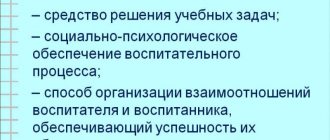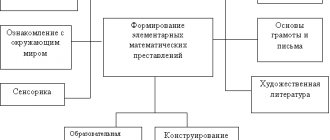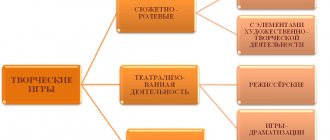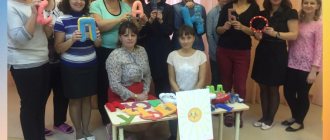Workshop “Organization of project activities in the implementation of the Federal State Educational Standard for Preschool Education in preschool educational institutions”
Currently, the teacher needs to develop the qualitative aspects of the child’s personality. Children's education is comprehensive - thematic in nature, the basis of which is the eventfulness of the surrounding reality. However, to implement the educational process, it is necessary to meet basic requirements: the educational load on children cannot be increased so as not to harm children’s health. But how then to plan thematic activities that contain diverse areas of education?
To solve this problem, there is a project method
.
Slide No. 3, 4, 5
Concept of project and project activity
A project is a set of actions specially organized by an adult and carried out by children, culminating in the creation of creative works.
The project method is a teaching system in which children acquire knowledge in the process of planning and performing increasingly complex practical tasks - projects. The project method always involves students solving some problem.
The project method describes a set of actions of a child and methods (techniques) for a teacher to organize these actions, that is, it is a pedagogical technology
The main thesis of the modern understanding of the project method, which attracts many educational systems, is that children understand why they need the knowledge they receive, where and how they will use it in their lives.
SLIDE No. 6
In the Federal State
Educational Standard of Preschool Education dated October 17, 2013 No. 1155, which came into force on January 1, 2014, it is stated that it is necessary to develop motivational readiness for learning, and not just teach the child to read, write, etc. After preschool life, the desire to learn should appear.
SLIDE No. 7, 8, 9
Relevance of the project method
;
The project method as a pedagogical technology is a set of research, search, and problem-based methods that are creative in nature, that is, it is based on the development of children’s cognitive skills, the ability to independently construct their knowledge, navigate the information space, and develop critical and creative thinking.
Slide No. 10
The importance of projects
Working on a project is of great importance for the development of a child’s cognitive interests. During this period, integration occurs between general methods of solving educational and creative problems, general methods of thinking, speech, artistic and other types of activity. Through the unification of various areas of knowledge, a holistic vision of the picture of the surrounding world is formed.
The collective work of children in subgroups gives them the opportunity to express themselves in various types of role-playing activities. Common cause develops communication and moral qualities.
Workshop for teachers “Project activities in kindergarten” methodological development
Workshop for educators
“Project activities in kindergarten”
Goal: to provide conditions for the development of creativity and professional activity of teachers in their mastery of design technology, to unite the efforts of the kindergarten team to use the achievements of advanced experience and pedagogical science in practice.
Tasks:
— improve the pedagogical skills of teachers;
— to increase the methodological level of teachers in their mastery of design technology;
- promote creative exploration.
Form of implementation: sea voyage.
Preliminary work:
-preparation of an information stand about the planned workshop;
— selection and study of literature on the use of the project method in kindergarten;
- production of handouts.
Didactic material and equipment: tickets for each participant, task cards, “Project Activity Algorithm” templates for each team, tape recorder, audio recording of the sound of the sea.
Seminar/workshop progress:
Dear colleagues. I'm very glad to see you. The topic of our meeting: “Project activities in kindergarten”
We face the following tasks:
- improve teaching skills,
— increase the methodological level in mastering design technology,
- promote creative exploration.
Using the project method in preschool education, as one of the methods of integrated teaching of preschoolers, can significantly increase children's independent activity, develop creative thinking, children's ability to independently find information about an object or phenomenon of interest in different ways and use this knowledge to create new objects of reality. It also makes the educational system of preschool educational institutions open to the active participation of parents.
Touching on this topic, I propose to go on a pedagogical journey on our steamship “Fairytale Polyanka” to the warm shores of project activity on the island of Projects. To refresh and use your knowledge of the design method in your creative work.
You have already purchased tickets, so please take your seats in your “cabins” (teachers are seated at tables, each table has its own name, all the tasks that will be needed for subsequent work are prepared on it).
So. Let's set sail. Close your eyes, sit back and listen to the sound of the sea (recording the sound of the sea). Open your eyes, we are already far from the shore, the ocean is all around. In the meantime, while we are gently swaying on the waves, let's remember what the Project is. For fruitful work, I ask you to unite in your cabins around the tables. Take ticket number 1 and discuss the task. One of the cabins needs to answer the question asked.
1 Task: Choose a definition of what a project is?
The project is………
1. Collection and presentation of comprehensive information on a given topic from various sources, including the presentation of various points of view on this issue, the presentation of statistical data, interesting facts (abstract, report, report);2. A way of communicating and transmitting information from person to person in the form of oral and written messages, body language and others (communication);3. Work aimed at solving a specific problem, achieving a pre-planned result in an optimal way (project);4. This is providing conditions for the development of universal human values in children, the formation of moral meanings and attitudes in them - attitudes towards the world according to the laws of Good, Truth, Beauty (education);
5. This is the child’s desire for coordinated, well-coordinated work in a children’s team (cooperation)
Well done, you completed the task quickly.
Today the state has set a task to prepare a completely new generation: active, inquisitive. And preschool institutions, as the first step in education, already have an idea of what a kindergarten graduate should be like, what integrative qualities he should have. Project activities will help to connect the process of learning and education with real events in the life of a child, as well as to interest him and captivate him in this activity. It allows you to unite teachers, children, parents, teach you how to work in a team, collaborate, and plan your work. Each child will be able to express themselves, feel needed, which means they will gain confidence in their abilities.
In the etymological dictionary, the word “project” is borrowed from Latin and means “thrown forward,” “protruding,” “conspicuous.” Translated from Greek, a project is a path of research.
It was revealed that the concept of “project” is a method of pedagogically organized development of the environment by a child in the process of step-by-step and pre-planned practical activities to achieve the intended goals.
A project also means an independent and collective creative completed work that has a socially significant result. The project is based on a problem; solving it requires research in various directions, the results of which are generalized and combined into one whole.
The project method is a pedagogical technology, the core of which is the independent activity of children - research, cognitive, productive, during which the child learns about the world around him and embodies new knowledge into real products. The essence of the “project method” in education is such an organization of the educational process in which students acquire knowledge and skills, experience in creative activity, an emotional and value-based attitude to reality in the process of planning and performing gradually more complex practical tasks of projects that have not only cognitive, but also pragmatic value.
The main goal of the project method is the development of a free, creative personality, which is determined by the developmental tasks and tasks of children's research activities.
The specificity of interaction using the project method in preschool practice is that adults need to help the child discover a problem or even provoke its occurrence, arouse interest in it, but at the same time not overdo it with help and care. The project method is based on the idea of focusing the cognitive activity of preschoolers on the result that is achieved in the process of joint work of the teacher, children, and parents on a specific practical problem (topic). Project activities in kindergarten are in the nature of cooperation, in which children, parents, and preschool teachers take part.
Planning of project activities should begin with the questions: “Why is the project needed?”, “For what purpose is it being carried out?”, “What will be the product of the project activities?”, “In what form will the result of the project be presented?” Generalization: Thus, in In project activities, the role of an adult is great: friend, mentor, observer, discoverer, etc. In order to carry out such work aimed at solving a specific problem, at achieving a pre-planned result in an optimal way, the teacher must be able to negotiate, distribute responsibilities, develop the personality of each child, without offending or infringing anyone, be able to hear and listen. And this is very difficult.
Now I suggest you try to do this work. Take ticket number 2 and complete the task.
2 Task: Psycho-gymnastics “Be careful...”
Team members stand near their chairs. They need to calculate in order up to 33. But for each number “3” and the number that is divisible by this number, they need to clap their hands. The test reveals skills such as listening and hearing others. After a minute of preparation, the teams begin to complete the task.
Our journey to Project Island continues. Open ticket No. 3 and let's remember what kind of projects there are. First read the task, discuss it, and then answer the question.
3 Task: Choose a definition.
| Research projects are... | Children conduct experiments, observations, after which the results are presented in the form of newspapers, books, albums, exhibitions, and more. |
| Creative projects are... | After the project is brought to life, the result is formalized in the form of a children's party. |
| Information projects are... | Children collect information and implement it, focusing on their own social interests (design of the group, individual corners, etc.). |
| Game projects are... | These are projects with elements of creative games, when children take on the role of characters from a fairy tale, solving problems and tasks in their own way. |
Thus, we see that projects are classified:
a) according to the dominant method (research, information, creative, gaming),
b) by the number of participants (individual, pair, group and frontal);
c) by duration (short-term, medium-term and long-term),
d) by the nature of contacts (carried out within one age group, in contact with another age group, within a preschool educational institution, in contact with family, public organizations... (open project). (E.S. Evdokimova “Design technology in a preschool educational institution”, M. 2006)
Work on the project, including the drawing up of a reasonable action plan, which is formed and refined throughout the entire period, goes through several stages. At each of them, the teacher’s interaction with children is personality-oriented.
To determine the stages of project activity, open ticket No. 4.
4 Task: Determine the stages of project activities.
Participants need to think and determine the stages of work on the project. Present your generalizations.
Thus, the first stage of project development is problem identification and goal setting. As a result of a joint discussion, a hypothesis is put forward, which the teacher proposes to confirm in the process of search activity. First, a general discussion is held so that the children find out what they already know about a certain subject or phenomenon. The teacher can record the children's answers on a large piece of whatman paper. To do this, it is better to use conventional symbols that are familiar and accessible to children. Then the teacher asks the question: “What do we want to know?”
At the second stage, children make suggestions to the question: “How can we find answers to the questions?” The solution to this question can be various activities: reading books, encyclopedias, seeking help from parents, kindergarten specialists, going on an excursion, conducting an experiment, and so on. The teacher helps children plan their activities in solving assigned tasks and assign roles.
The third stage is practical - children explore, create, search. To activate children's thinking, the teacher offers to solve problem situations and puzzles. It is necessary that the teacher can create a situation where the child must learn something on his own, guess, try, invent something. The environment around the child should be, as it were, unfinished, unfinished.
The fourth stage is the presentation of the project. Depending on the age of the children, the result of the project can be: final games - activities, games - quizzes, mini-museums, creative newspapers, design of albums, exhibitions and more.
5 Task: Answer the question.
Insert the missing phrase into the definition:
— The integrated teaching method is for preschoolers... (informational; experimental; experimental-research, innovative).
— The essence of the “project method” in education is such an organization of the educational process in which students acquire... (first knowledge about the world around them, skills in communication and solving applied problems; knowledge about the world indirectly, through books, communication, television, and other sources ; knowledge and skills, experience of creative activity, emotional and value-based attitude to reality in the process of planning and performing gradually more complex practical tasks - projects; ability to adapt to a new team).
Thus, work on the project is interesting because the range of children’s knowledge turns out to be extremely wide, and it is constantly increasing, as children begin to acquire knowledge on their own, using all available means.
The method of designing the activities of preschoolers at the present stage of development of preschool education is one of the priorities.
This is how you and I unnoticed found ourselves off the coast of the island of projects.
I suggest everyone warm up and take a walk on the hot sand.
Game "Who is faster".
I will name the numbers. Immediately after the number is called, exactly as many people as the number was announced should stand (no more and no less). For example, if I say “four,” then four of you should stand up as quickly as possible. They will be able to sit down only after I say “thank you.” The task must be completed silently. Tactics for completing a task should be developed in the process of work, focusing on each other’s actions.”
The guys in the senior group act in a physical education lesson in a harmonious and friendly manner.
And now I propose to answer humorous questions.
— What’s in front of Boris, and what’s behind in Gleb? (Letter "B").
—Which watch shows the exact time only 2 times a day? (Which stopped).
- How do day and night end? (Soft sign).
— Two birch trees are growing. Each birch tree has 4 cones. How many cones are there in total? (Cones do not grow on birch trees).
Well, what great fellows you are, just like the guys from the middle group. They easily cope with developmental tasks and conduct search activities together with their teachers.
And now I suggest taking your places in the cabins, it’s time to return to kindergarten (sound of the sea).
The project method as a pedagogical technology is a set of research, search, problem-based methods that are creative in nature, that is, it is based on the development of children’s cognitive skills, the ability to independently construct their knowledge, and navigate the information space.
While we are sailing back home, I propose to exchange our impressions and continue the phrase: “Today I...”
“Dreams are the sails of our lives. You can swim without them, but slowly and not far. And I wish for you that your ship “Work” always sails confidently and is accompanied only by positive emotions. I wish you creative success. Thanks for the work.
Regional seminar on project activities invites you!
Most recently, the webinar room of the media “World of Preschool Children” hosted sessions of sections of the All-Russian Conference on Lean Technologies.
And today we are announcing the start of the Regional Scientific and Practical Seminar “Project activities as a means of developing cognitive, creative, communicative activity of preschool children in the conditions of the Federal State Educational Standard for Education”
Nowadays projects in kindergartens as a type of activity are quite in demand. They are interesting to both invent and implement, and there is a final product that can be both imagined and seen...
A wide variety of projects are often sent to our portal! sometimes they give advice on how best to design it, how to write it, how to implement it. And that is why this particular topic of conducting a scientific and practical seminar arose.
For this seminar, we ask you, dear participants, to send a VIDEO about your one specific project!
In the video you will talk about why such a project arose, how you came up with it, then how you implemented it, and what happened in the end. What the pupils, teachers achieved and what the parents received... We want to see PRACTICAL implementation of your projects . There is no need to write a bare theory. Everyone already knows it and can read it on the Internet. We are very interested in VIDEOS IN THE FORM OF REPORTS - how the project came about, how it went, what results it brought. We understand that many projects have already been completed - and the result is not always possible to show. But you still have the photos! A video report can also be made in slide show format from photographs. If possible, then in the form of a report... Well, if nothing works out at all, turn on the presentation on a multimedia installation and speak against its background. The only thing is that there should be LITTLE text in presentations... and more illustrative and photographic material.
And to implement it in practice - that’s why we came up with exactly this format of the seminar - in a video presentation, talk about your specific project that has ALREADY been carried out, be it short-term, medium-term or long-term.
Advertising message
Moreover, your video will to some extent be able to replace your presentation in the webinar room, which is still beyond the capabilities of many...
We will be very grateful if you send not the video itself, but a link to it from the service https://www.youtube.com/, it will be faster and more convenient - both for us and for you...
We divided the sections at the seminar according to educational areas presented in the Federal State Educational Standard for Education. –
1. Projects aimed at social and communicative development; 2. Projects aimed at cognitive and speech development; 3. Projects aimed at artistic and aesthetic development; 4. Projects aimed at physical development.
AND ELSE - you can send projects that you have completed both for teachers and for parents, and, for example - internetworking - we will make a separate section for such projects!
The seminar is held in 3 stages:
First stage:
Stage 1: October 26 – November 30, 2022:
Reception of materials, publication of materials on the portal, formation of a table of participants for speaking in webinar format at the seminar site according to the schedule presented in the Appendix below.
Second phase:
Stage 2: December 7 – 10, 2022 from 18 to 20 hours. Moscow time
Speech by seminar participants in sections, in the format of an online webinar room.
Stage 3: December 11, 2022 – January 30, 2022 –
printing of the final collection of the Regional scientific and practical seminar “Project activity as a means of developing cognitive, creative, communicative activity of preschool children in the conditions of the Federal State Educational Standard for Education”. (Printing certificates will be issued in DECEMBER 2022!)
And now - POSITION
TABLE OF PARTICIPANTS BY SECTION
We are waiting for your materials and ask you to share the information with your colleagues!
Click on the social media buttons and invite your colleagues to participate!





